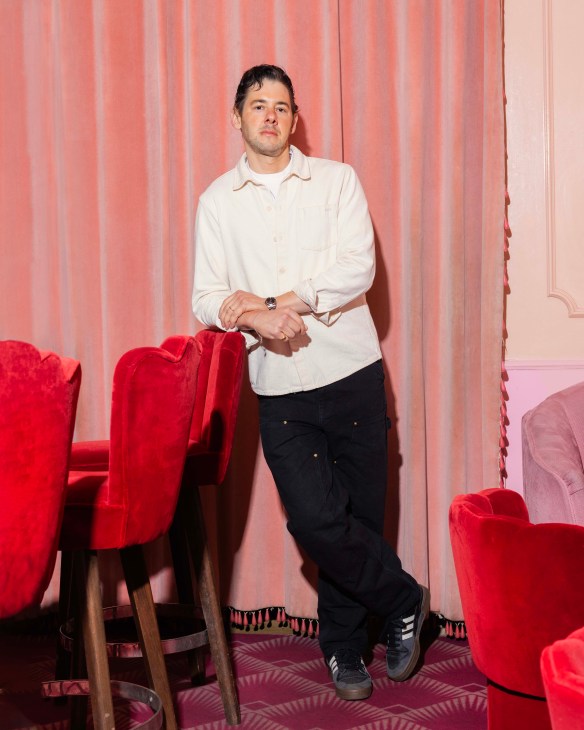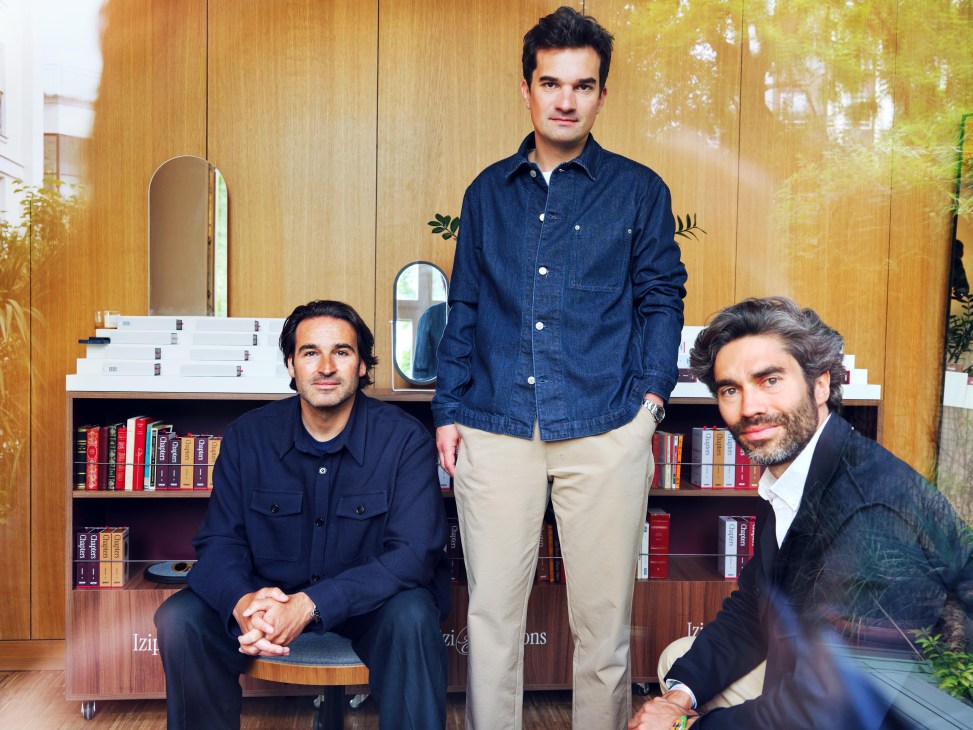Innovative entrepreneurs Ari S Heckman and Charles Brun bring fresh visions to hospitality and eyewear markets
These business leaders built their success on finding fresh ways to revive overlooked ideas or places. Here’s how they did it.
1.
Ari S Heckman
Ash
While most US hospitality brands would be looking for big-city locations, Ash is taking a different path, opening in North American cities overlooked by larger companies. The four properties (a fifth opens this summer in Richmond, Virginia) are the work of Ari S Heckman. Part architect and part interior designer, he is also a property developer, furniture buyer and hotelier. He runs a creative studio in New York – a city where, pointedly, he doesn’t run a hotel.

Heckman seeks out what he calls “underdog” cities with overlooked building stock. In 2014, Ash’s first hotel, The Dean, opened in a former brothel in Providence, Rhode Island’s state capital. (It was renamed The Neptune in May 2025.) The Siren in Detroit resides in a 13-storey Italianate Renaissance-style skyscraper, which Ash restored to its 1920s period glory (when the city, perhaps not quite uniquely, was known as “the Paris of the Midwest”). Hotel Ulysses embraces Baltimore’s Gilded Age stateliness with a touch of camp, says Heckman, in homage to hometown filmmaker John Waters.
Ash’s shops sell vintage ashtrays, pyjamas and umbrellas, as well as a selection of custom furniture and bath products. Meanwhile, Ash Staging outfits homes for sale or rent in the hotter New York and Los Angeles property markets. Monocle sat down with Heckman to find out more.
What drew you to the hotel business?
Vibrant cities always have at least one great hotel. They become a living room or embassy for their city – they’re more than just a place for lodging. People used to go to hotels just to send a telegram. I lamented that I grew up in the era of postwar suburbanisation. I was mystified that we had vibrant, walkable urban environments all over the country – not just in New York – and hollowed them out. I found that scandalous and depressing. But I came of age during the first wave of urban revitalisation, which has been an animating force for my career. The prospect of participating in the comeback of the American city by being a hotelier excited me.
Your hotels have a cinematic quality. Was that intentional?
I want a guest to walk through the front doors and feel an all-encompassing attention to detail. Our scent is filtering through the air; the playlist matches the time of day. Every detail of the interior, from the furniture to the wall finishes, feels super keyed into the building that you’re standing in. The lighting is just so. Those attributes create this sense of fantasy and escapism, which is our value proposition. Obviously, it’s a priority that everyone gets a good night’s sleep but it should feel as though you’re going on a vacation within a vacation or on a trip within your business trip. You’re on set and living in this immersive world. I want to build multifaceted snow globes that someone can inhabit when they visit us.
Any favourite designers or furniture makers for your interiors?
Everything is custom or vintage. I love acquiring found objects and antiques, so we’re constantly shopping around the world. At our properties you can’t just identify where something came from off the shelf, other than maybe the plumbing fixtures – and we sometimes custom-design even those. For a hotel, that’s a maniacal approach. It’s why the projects take so long. Often something is particular to a hotel and it will never be made again.
Why underdog cities?
Global cities have become like expensive luxury goods. Creators and coolness have been pushed out. Underdog cities have become the places where culture is being made and nightlife is happening. Opening a hotel in Baltimore or Detroit – I like the idea of changing people’s perception and creating a sense of discovery. Then we become a partial catalyst for other new openings around us. I’m so attracted to cities because they have this unique kinetic energy: activity becomes contagious, like a flywheel effect. That’s harder in a suburb.
So no Ash country retreat?
Never say never. We are urban-focused but I am interested in other types and styles of hospitality. I would love to do an old motel project. We’re also looking at international growth and expansion to Europe and Latin America. Europe has some fascinating markets and gateway cities such as Genoa and Naples. Even Rome. We model our approach on European hospitality. We’re definitely looking beyond just underdog cities. I like underdog buildings and neighbourhoods too – places where you’re reimagining or doing something unexpected. The definition is becoming more elastic as we mature but the ethos is the same.
ash.world
2.
Charles Brun
Izipizi
“It’s a friendship story,” says Charles Brun, who co-founded French eyewear brand Izipizi in 2010 with former schoolmates Xavier Aguera and Quentin Couturier. “It’s also a family story.” The trio, who grew up together in Lyon, drew inspiration from their stylish mothers, who lamented the lack of off-the-peg but well-designed spectacles available at petrol stations and pharmacies. “Our idea at the time was to design and create cool reading glasses,” says Brun.

Now, 15 years later, the brand is setting its sights on further expansion into the US market. “We love working out of here,” says Brun as he whizzes Monocle through Izipizi’s New York office. It’s not quite as big and impressive as Izipizi House – the company’s HQ in Paris, which has a sunny courtyard – but it’s a nice space for the US arm, which has a team of eight employees. Brun used to travel frequently between France and the US but since appointing Jonathan Crespo – formerly global senior director at Oliver Peoples – as Izipizi’s North America CEO in 2024, he now visits just once a month.
Izipizi has a warehouse outside Chicago and the sunnies and specs are now stocked in more than 600 shops in the US, with more partnerships on the way (including with Goop). The brand is also testing the waters with Amazon, which will stock a core collection for a six-month trial. It’s more mass-market than usual for Izipizi, which has mostly leaned towards niche, independent stockists so far – but Brun believes that if you want to bring a European brand into the US market, you have to adapt. “We realised that everybody buys things on Amazon, including our customers,” he says.
This is all part of the plan to improve Izipizi’s footprint. “We believe that the US should be our biggest market,” says Brun. Approximately 75 per cent of the brand’s sales are concentrated in Europe but America is the brand’s largest market outside the continent. The team is meeting brokers and agents in New York to scout out locations for potential retail spaces. (Los Angeles and Miami are expected to follow.)
When the friends first launched the brand, they favoured selective distribution. “We wanted to be in the best shops around the world,” says Brun. The first major retail breakthrough came when Colette, the iconic Parisian concept shop founded by Colette Roussaux, agreed to stock their wares. “Colette understood the need for stylish options,” he says. The resulting exposure helped them to stake out space in the market. “During fashion week, tastemakers and buyers from across the globe would visit to see what products were featured,” says Brun.
Izipizi expanded into other Parisian retailers including Merci and Le Bon Marché. It secured spots in London in department stores such as Harrods and Selfridges, as well as in Asia, which now represents about 10 per cent of the brand’s global turnover. South Korea and Japan are major markets. When it launched a collaboration with New York-based Engineered Garments in Tokyo, the line sold out in three days. But Izipizi turned down many proposals from larger chains. “We didn’t want to damage the brand,” says Brun. “We were in the mindset of building it step by step and making sure that we had the best shops.”
What sets the company apart is that it offers sophistication while keeping products affordable, with an average pair costing about €50 or €60. The brand has also remained relevant by offering new riffs on classic designs, as well as dropping fresh products and collections. One big bet is a range developed with a Swiss researcher for those who struggle to fall asleep. The glasses block blue light, aiding the brain’s natural melatonin levels and helping people to doze off. Izipizi tested them on 300 insomniacs over the course of three months. “Eighty per cent of them told us that they loved it,” says Brun.
Another focus for the brand is sustainability. It has cut the carbon emissions of producing its glasses nearly in half since 2019, becoming B-Corp certified in 2023. By the end of 2025, the company is aiming for all of its eyewear to be made from bio-based materials. For the past 12 years, it has worked with a family-owned supplier in Taiwan. “We chose it because of its values,” says Brun, who sees this as one of the brand’s best decisions – not least because of the tariffs that the US has imposed on countries including China. “Our philosophy is not to overreact,” says Brun. “Step back, observe and take time before making a decision.”
Expansion is crucial for Izipizi but so is staying true to its principles. Despite being available in 90 countries and more than 7,500 shops, the brand is trying to preserve the close-knit, family-like atmosphere that fuelled its launch 15 years ago. “It has been a wonderful adventure and we want it to continue,” says Brun. He believes that a successful company is built on a strong team. “Without partners, I would be nothing. Izipizi wouldn’t be ‘easy peasy’.”
izipizi.com


